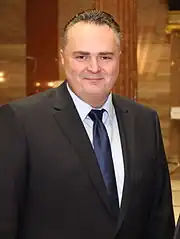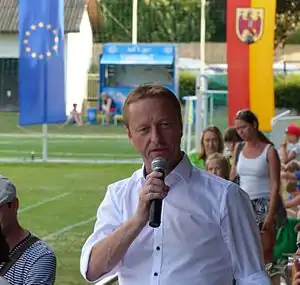| |||||||||||||||||||||||||||||||||||||||||||||||||||||||||||||||||||||||||||||
All 36 seats in the Landtag of Burgenland 19 seats needed for a majority | |||||||||||||||||||||||||||||||||||||||||||||||||||||||||||||||||||||||||||||
|---|---|---|---|---|---|---|---|---|---|---|---|---|---|---|---|---|---|---|---|---|---|---|---|---|---|---|---|---|---|---|---|---|---|---|---|---|---|---|---|---|---|---|---|---|---|---|---|---|---|---|---|---|---|---|---|---|---|---|---|---|---|---|---|---|---|---|---|---|---|---|---|---|---|---|---|---|---|
| Turnout | 187,497 (74.9%) | ||||||||||||||||||||||||||||||||||||||||||||||||||||||||||||||||||||||||||||
| |||||||||||||||||||||||||||||||||||||||||||||||||||||||||||||||||||||||||||||
 Results by municipality. | |||||||||||||||||||||||||||||||||||||||||||||||||||||||||||||||||||||||||||||
| |||||||||||||||||||||||||||||||||||||||||||||||||||||||||||||||||||||||||||||
The 2020 Burgenland state election was held on 26 January 2020 to elect the members of the 22nd Landtag of Burgenland. The snap election was called in the wake of the Ibiza affair in May 2019, which caused the Social Democratic Party of Austria (SPÖ) to terminate its coalition with the Freedom Party of Austria (FPÖ).[1]
The centre-left SPÖ achieved its best result since 2005, winning an absolute majority on a swing of eight percentage points. The conservative Austrian People's Party (ÖVP) improved on its 2015 result, but did not gain any seats. The FPÖ lost a third of its votes, falling to 9.8% and four seats. The Greens stayed level, while List Burgenland (LBL) lost most of its votes and both of its seats. The net result was a shift of four seats to the SPÖ.
The SPÖ's unexpectedly strong result came after a string of election losses since 2017, including its worst-ever result in the 2019 federal election result three months earlier.[2] Commentators attributed this to the conservative positions on immigration and national security taken by Governor Hans Peter Doskozil.[3] Burgenland is a traditional stronghold of the SPÖ, who have governed the state continuously since 1964.
Due to its Landtag majority, the SPÖ did not seek a coalition partner, and entered government alone. Doskozil was sworn in as Governor for a second term on 17 February. Fellow SPÖ member Astrid Eisenkopf became Deputy Governor, the first woman to hold the position in Burgenland.[4]
Electoral system
The 36 seats of the Landtag of Burgenland are elected via open list proportional representation in a two-step process. The seats are distributed between seven multi-member constituencies, corresponding to the seven districts of Burgenland (the statutory cities of Eisenstadt and Rust are combined with Eisenstadt-Umgebung District). Apportionment of the seats is based on the results of the most recent census.[5]
For parties to receive any representation in the Landtag, they must either win at least one seat in a constituency directly, or clear a 4 percent state-wide electoral threshold. Seats are distributed in constituencies according to the Hare quota, with any remaining seats allocated using the D'Hondt method at the state level, to ensure overall proportionality between a party's vote share and its share of seats.[5]
In addition to voting for a political party, voters may cast preferential votes for specific candidates of that party, but are not required to do so. These additional votes do not affect the proportional allocation based on the vote for the party or list, but can change the rank order of candidates on a party's lists at the state and constituency level. Voters may cast one preferential vote at the state level, or three at the constituency level. A voter may not cross party-lines to cast a preference vote for a candidate of another party; such preference votes are invalid.[5]
Contesting parties
| Name | Ideology | Leader | 2015 result | |||
|---|---|---|---|---|---|---|
| Votes (%) | Seats | |||||
| SPÖ | Social Democratic Party of Austria Sozialdemokratische Partei Österreichs |
Social democracy | Hans Peter Doskozil | 41.9% | 15 / 36 | |
| ÖVP | Austrian People's Party Österreichische Volkspartei |
Christian democracy | Thomas Steiner | 29.1% | 11 / 36 | |
| FPÖ | Freedom Party of Austria Freiheitliche Partei Österreichs |
Right-wing populism Euroscepticism |
Johann Tschürtz | 15.0% | 6 / 36 | |
| GRÜNE | The Greens – The Green Alternative Die Grünen – Die Grüne Alternative |
Green politics | Regina Petrik | 6.4% | 2 / 36 | |
| LBL | List Burgenland Liste Burgenland |
Regionalism | Manfred Kölly | 4.8% | 2 / 36 | |
| NEOS | NEOS – The New Austria and Liberal Forum NEOS – Das Neue Österreich und Liberales Forum |
Liberalism Pro-Europeanism |
Eduard Posch | 2.3% | 0 / 36 | |
Opinion polling
| Polling firm | Fieldwork date | Sample size |
SPÖ | ÖVP | FPÖ | Grüne | LBL | NEOS | Others | Lead |
|---|---|---|---|---|---|---|---|---|---|---|
| 2020 state election | 26 Jan 2020 | – | 49.9 | 30.6 | 9.8 | 6.7 | 1.3 | 1.7 | – | 19.3 |
| Karmasin Research | January 2020 | 500 | 43.0 | 32.0 | 10.0 | 9.0 | 2.0 | 3.0 | 1.0 | 11.0 |
| Hajek | 29 Nov–16 Dec 2020 | 800 | 41–43 | 31–33 | 10–12 | 7–9 | 1–2 | 4 | 3–4 | 8–12 |
| Hajek | March–April 2017 | ? | 43.0 | 26.0 | 17.5 | 6.5 | 4.5 | 2.5 | – | 17.0 |
| 2015 state election | 31 May 2015 | – | 41.9 | 29.1 | 15.0 | 6.4 | 4.8 | 2.3 | 0.4 | 12.8 |
Results
 | |||||||
| Party | Votes | % | +/− | Seats | +/− | ||
|---|---|---|---|---|---|---|---|
| Social Democratic Party of Austria (SPÖ) | 92,634 | 49.94 | +8.02 | 19 | +4 | ||
| Austrian People's Party (ÖVP) | 56,726 | 30.58 | +1.50 | 11 | ±0 | ||
| Freedom Party of Austria (FPÖ) | 18,161 | 9.79 | –5.25 | 4 | –2 | ||
| The Greens – The Green Alternative (GRÜNE) | 12,466 | 6.72 | +0.29 | 2 | ±0 | ||
| NEOS – The New Austria (NEOS) | 3,177 | 1.71 | –0.62 | 0 | ±0 | ||
| List Burgenland (LBL) | 2,336 | 0.26 | –3.56 | 0 | –2 | ||
| Invalid/blank votes | 1,997 | – | – | – | – | ||
| Total | 187,497 | 100 | – | 36 | 0 | ||
| Registered voters/turnout | 250,181 | 74.94 | –1.10 | – | – | ||
| Source: Burgenland Government | |||||||
Results by constituency
| Constituency | SPÖ | ÖVP | FPÖ | Grüne | NEOS | LBL | Total seats |
Turnout | ||||||
|---|---|---|---|---|---|---|---|---|---|---|---|---|---|---|
| % | S | % | S | % | S | % | S | % | S | % | S | |||
| Neusiedl | 48.9 | 3 | 31.5 | 2 | 10.2 | 6.0 | 1.6 | 0.7 | 5 | 73.9 | ||||
| Eisenstadt | 46.5 | 3 | 32.7 | 2 | 9.2 | 8.9 | 1.8 | 1.0 | 5 | 75.1 | ||||
| Mattersburg | 52.9 | 2 | 26.6 | 1 | 11.1 | 6.8 | 1.7 | 0.8 | 3 | 74.0 | ||||
| Oberpullendorf | 50.4 | 2 | 31.2 | 1 | 7.3 | 5.7 | 1.3 | 4.0 | 3 | 78.1 | ||||
| Oberwart | 53.6 | 3 | 28.1 | 1 | 10.5 | 5.4 | 1.9 | 0.5 | 4 | 75.8 | ||||
| Güssing | 48.0 | 1 | 34.5 | 1 | 9.0 | 5.7 | 2.1 | 0.7 | 2 | 77.3 | ||||
| Jennersdorf | 48.3 | 1 | 29.8 | 12.6 | 6.8 | 1.5 | 1.0 | 1 | 72.0 | |||||
| Remaining seats | 4 | 3 | 4 | 2 | 0 | 0 | 13 | |||||||
| Total | 49.9 | 19 | 30.6 | 11 | 9.8 | 4 | 6.7 | 2 | 1.7 | 0 | 1.3 | 0 | 36 | 74.9 |
| Source: Burgenland Government | ||||||||||||||
Preference votes
Alongside votes for a party, voters were able to cast a preferential votes for a candidate on the party list. The ten candidates with the most preferential votes on a state level were as follows:[6]
| Party | Pos. | Candidate | Votes | |
|---|---|---|---|---|
| SPÖ | 1 | Hans Peter Doskozil | 57,045 | |
| ÖVP | 1 | Thomas Steiner | 16,655 | |
| FPÖ | 1 | Johann Tschürtz | 7,948 | |
| GRÜNE | 1 | Regina Petrik | 2,865 | |
| SPÖ | 2 | Astrid Eisenkopf | 1,423 | |
| ÖVP | 18 | Patrik Fazekas | 1,403 | |
| ÖVP | 14 | Walter Temmel | 1,298 | |
| ÖVP | 8 | Christian Sagartz | 1,270 | |
| ÖVP | 3 | Carina Laschober-Luif | 1,218 | |
| ÖVP | 6 | Rudolf Strommer | 1,207 | |
References
- ↑ "Austrian Social Democratic provincial governor ends cooperation with Freedom Party". Reuters. 2019-05-19. Retrieved 2020-01-27.
- ↑ Network, EURACTIV (2020-01-27). "Sigmar Gabriel joins Deutsche Bank, frustrates social democrats". www.euractiv.com. Retrieved 2020-01-27.
- ↑ Grüll, Philipp (2020-01-27). "VIENNA - Landslide victory for social democrats in state elections". www.euractiv.com. Retrieved 2020-01-27.
- ↑ "Hans Peter Doskozil elected governor of Burgenland". burgenland.spoe.at (in German). 17 February 2020. Retrieved 3 August 2020.
- 1 2 3 "RIS - Landtag election regulation 1995 - Provincial law consolidates, version as of 03.08.2020". Burgenland Government.
- ↑ "Preferential votes". Burgenland Government.


